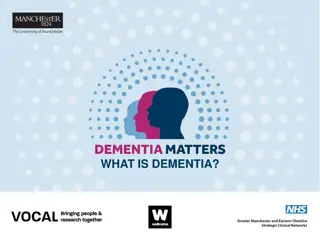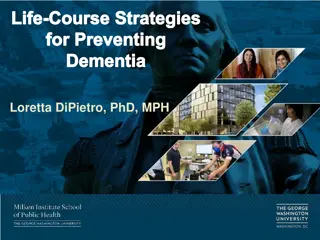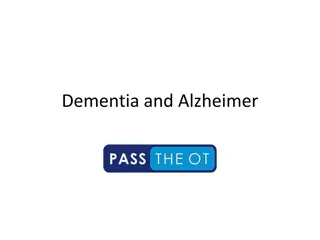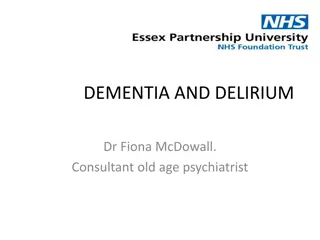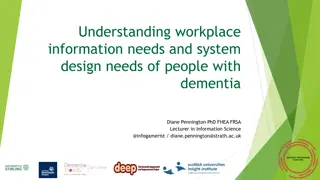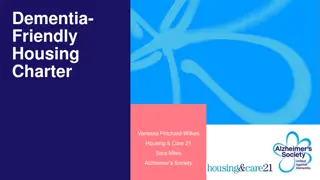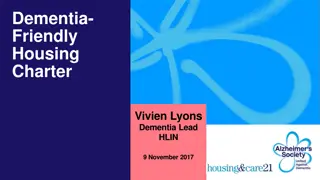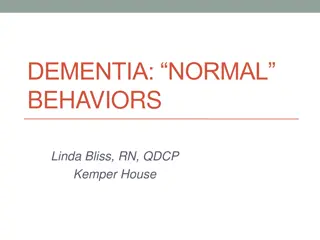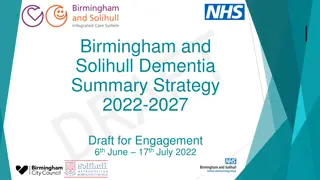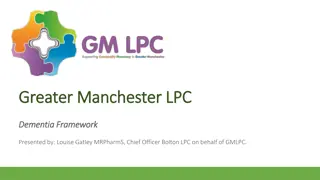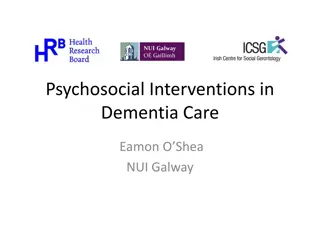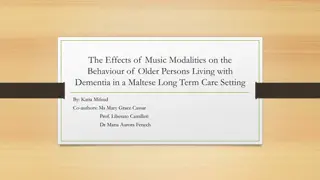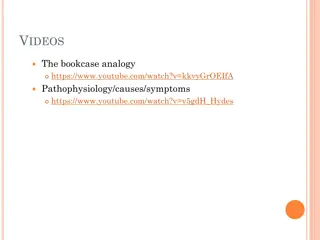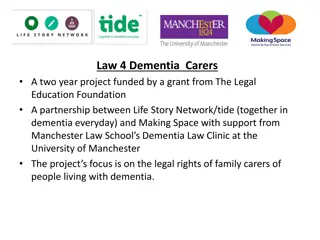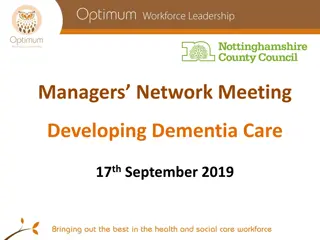Understanding Frontotemporal Dementia: A Case Study of Margaret
Margaret, a 61-year-old woman, is exhibiting symptoms suggestive of behavioral variant frontotemporal dementia (FTD). Her changing personality, inappropriate behavior, and memory issues are signs of FTD. This type of dementia involves frontal and temporal lobe degeneration, leading to alterations in behavior, emotions, and language skills. A thorough assessment is crucial to confirm the diagnosis and rule out other possible causes.
Download Presentation

Please find below an Image/Link to download the presentation.
The content on the website is provided AS IS for your information and personal use only. It may not be sold, licensed, or shared on other websites without obtaining consent from the author. Download presentation by click this link. If you encounter any issues during the download, it is possible that the publisher has removed the file from their server.
E N D
Presentation Transcript
A change in personality and behaviour
By the end of this module, learners will have: 1. Basic knowledge of the different ways in which frontotemporal dementia (FTD) behavioural and language variants might present Learning objectives 2. Basic knowledge of investigations that might help in the diagnosis of FTD 3. Basic knowledge of neuropathological types of FTD 4. Knowledge of the increased likelihood of inherited genetic mutations in FTD compared to other major types of dementia 5. An understanding of how young onset dementia might affect the lives of those living with the condition differently from late onset dementia
Margaret is a 61-year-old lady whose family have been growing increasingly worried about her. Margaret s husband Paul feels like he has been living with a different person for the past year, although when he looks back things have been changing for several years. Margaret was diagnosed with depression 2 years ago and didn t seem to get better from this. Margaret Mealtimes have become difficult recently because Margaret often asks for jam doughnuts and sometimes refuses to eat anything else Margaret had been working at a local newsagent but was asked to leave her job after swearing at customers Paul was very embarrassed at a church social event three months ago when Margaret began openly discussing their sex life with some of their acquaintances Margaret s memory is a bit worse than it used to be although she can usually remember details of recent conversations and events Margaret does not think there is a problem or that she needs any assessment
What might be causing Margaret s symptoms?
Frontotemporal dementia: Clinical features Margaret s symptoms are part of behavioural variant frontotemporal dementia (FTD) Frontotemporal dementia is the term used to describe a group of conditions that are characterized by degeneration of frontal and temporal lobes There are two main variants of FTD: In behavioural variant FTD (the most common variant) there are changes in personality and behaviour including disinhibition, apathy, loss of empathy, changes in food preferences and impulsivity In language variant FTD, language impairment is the main symptom at onset Although Margaret s history is strongly suggestive of behavioural variant FTD, thorough assessment and investigation is necessary to confirm this and to exclude less likely causes
How might clinical features of behavioural variant FTD show themselves? Clinical feature Example Disinhibition Apathy Lack of empathy Perseverative, stereotyped or compulsive/ritualistic behaviours Hyperorality and altered food preferences Cognitive impairment Lack of insight
How might clinical features of behavioural variant FTD show themselves? Clinical feature Example Disinhibition Embarrassing social interactions, excessive spending, gambling, impulsivity Apathy Blunted affect , loss of interest in activities that were previously enjoyable, loss of motivation Lack of empathy Unable to read other people s emotions or understand how they might be feeling in a given situation, loss of emotional warmth Perseverative, stereotyped or compulsive/ritualistic behaviours Repetitive movements like rocking/tapping/scratching/rubbing Complex behaviours like hoarding, cleaning rituals, new routines, obsessive new interests Habitual repetition of particular words, sentences or topics Hyperorality and altered food preferences Preference for sweet foods, binge eating, idiosyncratic eating/ food fads , eating non-food items, cramming food into mouth, messy eating Cognitive impairment Decline in executive function (planning, problem-solving, mental flexibility, attention). Relatively preserved memory and visuospatial skills. Lack of insight Inability to recognize the changes in behaviour and personality or the divergence from social norms
How might clinical features of language variant FTD show themselves?
How might the clinical features of language variant FTD show themselves? Language variants of FTD (lvFTD) are associated with several different types of language impairment. They are sometimes called primary progressive aphasias lvFTD are characterised by: Insidious onset and gradual progression of language difficulties which affect activities of daily living Language difficulties may be in the form of: Speech production Object naming Syntax Word comprehension People with lvFTD can also develop symptoms of behavioural variant FTD The diagnosis of lvFTD is based on language symptoms being the first to develop
Frontotemporal dementia: challenges in diagnosis There is often overlap between behavioural and language variants of FTD FTD is often not diagnosed for a considerable time after onset of symptoms Symptom onset is usually insidious FTD may be mistaken for other conditions, for example: Apathy is sometimes mistaken for depression Changes in personality are sometimes attributed to previously undiagnosed personality disorder (in the absence of thorough history-taking) Disinhibition/impulsivity is sometimes mistaken for mania FTD may present with a wide range of atypical symptoms, for example delusions and hallucinations which are sometimes mistaken for late onset psychosis, mania or other conditions Thorough assessment and a high index of suspicion of organic disorder when symptoms present in mid or late life are key to accurate and early diagnosis of FTD Complicating things still further, FTD can overlap with motor neurone disease and atypical extrapyramidal syndromes (e.g. cortocobasal syndrome, progressive supranuclear palsy)
What types of neuropathology underly the clinical syndromes of frontotemporal dementia?
What types of neuropathology underly the clinical syndromes of frontotemporal dementia? The pathology underlying FTD is diverse Key types of pathology known to underlie FTD are abnormalities in: Tau TDP-43 (transactive response DNA-binding protein 43 kD) FUS (fused in sarcoma protein) Neuropathological types do not correlate well with the different clinical syndromes of FTD
What investigations might be helpful in frontotemporal dementia?
What investigations might be helpful in frontotemporal dementia? Remember that a thorough history, mental state and neurological examination will often provide the information that is central to diagnosis Neuroimaging investigations supporting a diagnosis of FTD: MRI: Frontotemporal atrophy FDG-PET: Hypometabolism in frontal and temporal lobes Although helpful, this is a simplification and there are more subtle and complex changes which can help to understand more about the aetiology and subtypes of FTD, and the neurological networks underlying the symptoms. Please see the advanced reading section if you would like to find out more.
MRI in behavioural variant FTD with atrophy of frontal and temporal lobes
What investigations might be used in possible frontotemporal dementia? In some cases, advanced blood tests and cerebrospinal fluid analysis may be performed to rule out other (rare) causes of the person s symptoms
Might genetic testing be relevant? Why?
Might genetic testing be relevant? Why? About a third of people with frontotemporal dementia have an inherited genetic mutation Behavioural variant FTD is the most commonly inherited type (40-45%) Mutations in three genes account for the majority of genetic FTD: C9orf72 GRN MAPT Testing may be diagnostic for the person with FTD Genetic testing may be predictive for the children of the person with FTD There are a many complex factors to consider when a person with FTD or their family are deciding whether or not to undergo genetic testing, which are addressed during genetic testing
Living with frontotemporal dementia
Living with frontotemporal dementia: Urvashis story https://www.youtube.com/watch?v=nPg6xyeIoU0
Living at risk of frontotemporal dementia https://www.youtube.com/watch?time_continue= 1&v=D4pqhiDJQN8&feature=emb_logo
Urvashi and Amandas accounts are powerful and emotive Take some time to reflect on their experiences, either now or later
Supporting people with frontotemporal dementia and their families There are currently no medications that modify the disease process in FTD Medications may be used to manage some of the symptoms of FTD SSRIs may be helpful in reducing impulsivity Medications for motor symptoms may be helpful in types of FTD associated with motor symptoms Each person and each family s experience of dementia is unique, and a person-centred care plan is central to good care This might involve, for example, access to meaningful activity, carer support, respite care, dementia care mapping for behavioural symptoms Peer support groups for FTD can be helpful for families and carers of people living with FTD Everyone living with dementia should be offered the opportunity to take part in research
How might dementia impact differently on the person living with dementia and their families when it affects them at a younger age?
How might dementia impact differently on the person with dementia and their families when it affects them at a younger age? FTD tends to affect younger people (typical age of onset is 45-65) Young onset dementia is typically defined as dementia affecting people below the age of approximately 65 Alzheimer s disease is still the most common type of dementia in younger people Atypical types of Alzheimer s disease (e.g. FTD) and non-Alzheimer s dementias are more common in younger people than in older people
How might dementia impact differently on the person with dementia and their families when it affects them at a younger age? Some of the challenges that younger people living with dementia face include: Delays in diagnosis: Dementia is often not considered as a diagnosis in younger people, and dementia in younger people often presents with atypical symptoms. As a result, younger people wait on average more than four years from symptom onset to receive a diagnosis. Stigma: People are often not aware that younger people can be affected by dementia, and so do not understand the changes in the person living with dementia. Younger people living with dementia and their carers often find themselves feeling socially isolated. Financial: The person living with dementia and/or their carer may no longer be able to work and may not be able to access their pension yet. Delays to diagnosis might mean that reasonable adjustments are not made for them or that they miss out on medical retirement benefits.
How might dementia impact differently on the person with dementia and their families when it affects them at a younger age? Some of the challenges that younger people living with dementia face include: Children: Younger people with dementia may have young or adolescent children who have care needs of their own and who may struggle to understand the changes in their parent. Heritability: Young onset dementia is more likely than late onset dementia to be due to an inherited genetic mutation which has implications for both the person living with dementia and their children Difficulty accessing person-centred care: Support for people living with dementia is usually set up with the needs of older people in mind
Assess your knowledge Frontotemporal dementia refers to a clinically diverse group of disorders characterized by frontal and temporal lobe atrophy T/F MRI scans always show frontal and temporal lobe atrophy in frontotemporal dementia T/F Frontotemporal dementia is often mistaken for other conditions, especially early in its clinical course T/F Younger people living with dementia face a different set of challenges compared to older people living with dementia T/F Frontotemporal dementia mainly affects people in their 40s In most cases, an inherited genetic mutation is responsible for FTD T/F
Assess your knowledge Frontotemporal dementia refers to a clinically diverse group of disorders characterized by frontal and temporal lobe atrophy T MRI scans always show frontal and temporal lobe atrophy in frontotemporal dementia F (sometimes atrophy is not detectable on MRI, especially early in the clinical course of FTD) Frontotemporal dementia is often mistaken for other conditions, especially early in its clinical course T Younger people living with dementia face a different set of challenges compared to older people living with dementia T Frontotemporal dementia mainly affects people in their 40s F- the peak age at symptom onset in FTD is between 45 and 65 In most cases, an inherited genetic mutation is responsible for FTD F although an inherited genetic mutation can be identified in approximately a third of cases of FTD (which is far more than other major types of dementia)
Summary Frontotemporal dementia does not refer to a single condition but a group of conditions The most common type of FTD is behavioural variant FTD FTD can also present as a language variant FTD can be associated with atypical parkinsonian conditions and motor neurone disease FTD usually has onset between age 45 and 65 FTD usually has an insidious onset and gradual progression The wide range of presentations means that it is often misdiagnosed Careful history, mental state and neurological examination are essential FTD is caused by an inherited genetic mutation in about a third of cases A person-centred care plan is the keystone of good care in FTD; medication for symptomatic treatment has a limited role People living with young onset dementia have different needs in terms of assessment and support compared to older people It is essential that people with FTD and their families are offered the opportunity to take part in research to find better ways of caring for people with FTD and ultimately a disease modifying treatment
What can I do now? Learn more about FTD at the FTD Talk website: https://www.ftdtalk.org Learn more about how young onset dementia affects people living with dementia and their families: https://www.youngdementiauk.org/young-dementia-network Make sure you know how people living with dementia can access research: https://www.joindementiaresearch.nihr.ac.uk
Advanced reading Convery R, Mead S, Rohrer JD. Review: Clinical, genetic and neuroimaging features of frontotemporal dementia. Neuropathol Appl Neurobiol. 2019;45(1):6-18. doi:10.1111/nan.12535 O'Malley M, Parkes J, Stamou V, La Fontaine J, Oyebode J, Carter J. International consensus on quality indicators for comprehensive assessment of dementia in young adults using a modified e-Delphi approach [published online ahead of print, 2020 Jun 25]. Int J Geriatr Psychiatry. 2020;10.1002/gps.5368. doi:10.1002/gps.5368 https://www.raredementiasupport.org


